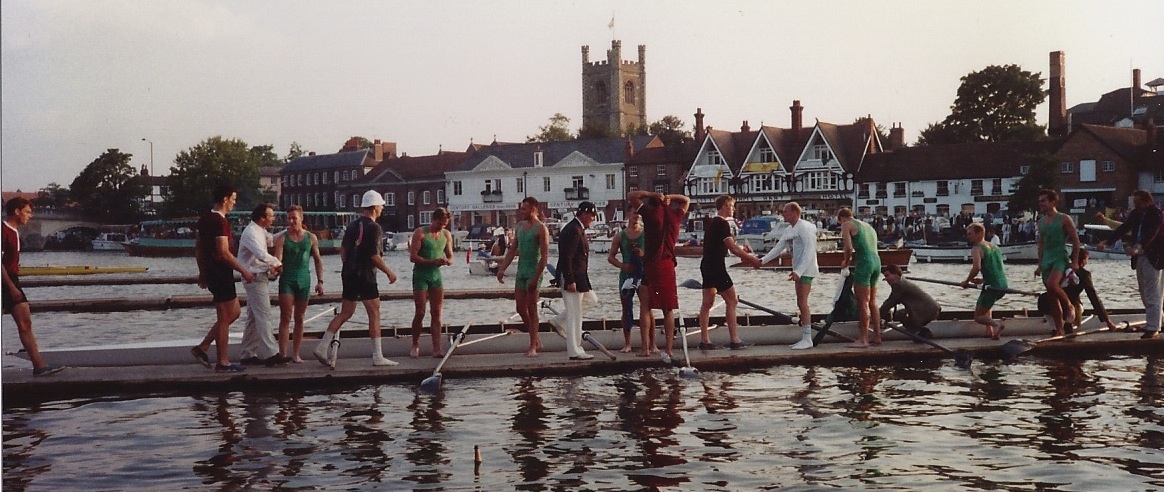The London Marathon is now established as one of the world’s premiere elite marathons. It is also probably one of the biggest mass-participation sporting events on the planet as well as one of the most successful charitable fund-raising events.
Today’s London Marathon course starts in Blackheath, heads east through Charlton and Woolwich before turning west and passing the Cutty Sark in Greenwich at around 6½ miles. Crossing the River Thames at Tower Bridge, the course heads east as it passes half-way and loops around the Isle of Dogs and Canary Wharf before heading west again along The Highway and the Embankment to Parliament Square, Birdcage Walk to the finish in front of Buckingham Palace. The event has transformed many of London’s iconic landmarks into sporting landmarks.
The finish has changed most over London’s near three-decades of city marathon history. The first London Marathon, held on 29 March 1981, finished on Constitution Hill between Green Park and Buckingham Palace. From 1982 until 1993 the race finished on Westminster Bridge with the Houses of Parliament in the background. But in 1994 repair work to the bridge meant the finish line was moved to The Mall where it has been ever since.
Elsewhere, alterations have been surprisingly few. In 2005 a cobbled area near the Tower of London – around 22 miles – was eliminated to the relief of elite and fun runners alike. The direction taken by runners around the Isle of Dogs between 14 and 21 miles switched from clockwise to anti-clockwise the same year.
In 2012, London’s third Olympic and first Paralympic Marathons will draw on the elite marathon expertise of the London Marathon organisers. They will be hoping that they will be able to stage races as dramatic as the first two London Olympic Marathons: in both, the gold medal slipped from the grasp of the leading athlete between entering the stadium and reaching the finishing line.
1908
London’s first Olympic Marathon in 1908 was also historically significant in defining the 26 mile 385 yards / 42.195 km distance that is now the standard.
The race started on the East Terrace of Windsor Castle from where the 55 competitors ran through Windsor town centre and across the Thames to Eton and then on to Slough. The course then continued on to Uxbridge, Ickneham, Ruislip, Eastcote, Pinner, Harrow, Wembley, Harlesden, Willesden and Old Oak Common before crossing Wormwood Scrubs to reach the Anglo-French Exhibition Grounds and the White City Stadium. Traveling along the route today, it is clear that today’s sprawling London suburbs were still very distinct villages in 1908, and much of the course would have had a distinctly rural feel.
The White City Stadium was the first stadium ever to be built specifically as the principal venue of an Olympic Games. It had a capacity of 150,000 or which 68,000 were seated but only 17,000 were protected from the elements. Incorporating a 1/3 mile running track, 660 yard banked cycle track and swimming pool, the Stadium was built by the organisers of the Anglo-French Exhibition in just 10 months. In later life, White City was also a soccer World Cup venue, hosting the Uruguay v France match in the 1966 tournament. The Stadium was demolished in 1985 and the site is now occupied by the BBC.
From Windsor to the stadium, the proposed 1908 course measured approximately 26 miles. On entering the stadium through entrance “QQ RR SS” in the south west corner, it was decided that the runners should turn left to run 385 yards around the track to the finish line immediately below the Royal Box.
Race day was 24 July. The Games’ official report describes how the “close, warm, and muggy atmosphere of that summer afternoon, when the sun was deceptively strong and there was very little air,” was to have a profound impact on a race which started started at a brisk pace: the first mile was completed in just 5 minutes and 1 second.
With a dozen British entries, it was home athletes who made the early running. Jack Price led the South African Charles Hefferon by 200 yards at half way – in Ruislip. Frederick Lord, another Briton, in third place was “laboured in his action” just ahead of the Italian Dorando Pietri.
Hefferon took the lead at 15 miles and attempted to make a decisive break. Pietri closed on Hefferon in Old Oak Common Lane and passed the South African as they approached Wormwood Scrubs. However, Pietri’s push was too much and he was almost unconscious when he reached the track, turning right instead of left in his confusion before collapsing.
In describing what rapidly became elevated to the status of legend, the official report says,
“As it was impossible to leave him there, for it looked as if he might die in the very presence of the Queen and that enormous crowd, the doctors and attendants rushed to his assistance. When he was slightly resuscitated the excitement of his compatriots was so intense that the officials did not put him on an ambulance and send him out, as they would no doubt have done under less agitating circumstances. The first fall and the first assistance rendered had, if it had been only realised, disqualified the Italian for the prize.”
Eventually, Pietri struggled to his feet and staggered to the tape in a time of 2 hours 54 minutes 46.4 seconds. Shortly afterwards, the American Johnny Hayes reached the finish without assistance in 2 hours 55 minutes 18.4 seconds. An official objection from the US team was eventually upheld and Hayes was awarded the gold medal.
Hefferon had hung on for silver and Joseph Forshaw, another American, took bronze. Queen Alexandra, who had witnessed the drama from the Royal Box, presented Pietri with a gold cup.
The events of London 1908 captured the public imagination, established the marathon as the ultimate sporting challenge and paved the way for a flurry of races between the leading protagonists over the now official distance which could be considered the forebears of modern city marathons.
Excluding the disqualified Pietri, only 27 of the 55 athletes finished the 1908 marathon. Given the sultry conditions, perhaps the instructions to competitors contributed to the high attrition: “Every competitor must wear complete clothing from the shoulder to the knees (i.e. jersey sleeved to the elbows and loose drawers with slips). Any competitor will be excluded from taking part in the race unless properly attired.”
Other aspects of the race would not be unfamiliar to modern marathon runners. As “official caterer” the Oxo Company provided refreshments. Rather than mineral water or energy drinks, 1908 athletes were offered an “Oxo Athlete’s Flask containing Oxo for immediate use” while hot or cold Oxo or Oxo and Soda were distributed at feeding stations along the route. Rice pudding, raisins, bananas, soda and milk. and stimulants were also available “in cases of collapse” while “eau de Cologne and sponges can be had for use of competitors from the Oxo representatives…”
Pietri’s exploits are commemorated today in Dorando Close which skirts the BBC White City complex. The location of the finish line of the old White City Stadium is marked on the site.
View London’s historic marathons in a larger map
Update: In his blog which examines sporting myths, US blogger Brian Cronin explores the connection between the British Royal Family and the official marathon distance.
1948
When the Olympics were resurrected after World War 2, the 1948 Games were centred on the Empire Stadium, Wembley. For the marathon, the organisers devised an out-and-back route that took runners north from Wembley in order to avoid the many roads that were still bomb-damaged in inner London. The course also climbed more than 300 feet as it progressed from Middlesex into Hertfordshire.
The Marathon Race on the final afternoon of the track and field events – a warm, humid and windy day – was curiously reminiscent of the Pietri race forty years earlier.
Around six miles, Etienne Gailly, a 25-year old Belgian who had escaped from occupation during the war, eventually reached Britain and joined Belgrave Harriers, moved to the front of the field of forty-one. At 15 km. he had a lead of 14 seconds and extended this to half a minute by 20 km. At 30 km. Gailly was 53 seconds ahead of the Argentinian Delfo Cabrera but five kilometres later Choi Yoon-chil of Korea had moved into a 28-second lead over Cabrera, with Gailly another three seconds behind. Choi dropped out with injury around 38 km. With 5,000 metres to go, Cabrera was leading, just five seconds ahead of Gailly.
It was Gailly who entered the Stadium first “exhausted and hardly able to drag one foot after the other” yet needing to complete a little over a lap of the track to secure the Olympic title. Within a few seconds, Cabrera entered the stadium and had no difficulty in overhauling the “practically insensible” Belgian to snatch the gold in a time of 2 hours 34 minutes 51.6 seconds. Welshman Tom Richards was the third to enter the Stadium and he too had little difficulty passing Gaily taking the silver in 2 hours 35 minutes 7.6 seconds. The gallant Gaily held on to finish third in 2 hours 35 minutes 33.6 seconds, just over half a minute ahead of the South African Johannes Coleman, who had finished sixth in the 1936 Berlin Games. In one of the closest Olympic Marathon finishes of all time, the first four athletes were running their final laps of the stadium at the same time.



